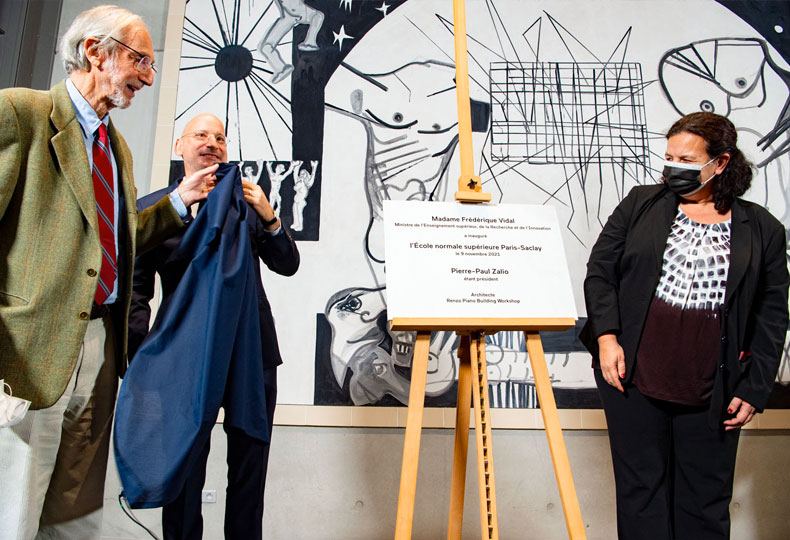Inauguration of the ENS Paris-Saclay

Inauguration Tuesday, November 9, 2021
Numerous personalities were present this Tuesday, November 9, 2021 to inaugurate the School.
Mrs. Frédérique Vidal, Minister of Higher Education, Research and Innovation, and the official delegation discovered the different areas of our building: the garden, the main footbridge, the Germaine Tillon Atrium, the students' living spaces, the Civil Engineering and Mechanical Engineering classrooms, and the Emmy Noether event hall.
After the speeches, the Minister Frédérique Vidal, the President of the School Pierre-Paul Zalio and the architect Renzo Piano unveiled the inaugural plaque in the presence of :
- Sylvie Retailleau, President of the Université Paris-Saclay
- Eric Jalon, Prefect
- Bernard Charles, Director of Dassault Systèmes
- Michel Bournat , Mayor of Gif-sur-Yvette
- Cédric Villani, Member of Parliament for Essonne
- François Durovray, President of the Essonne Departmental Council
- Philippe Van de Maele of the Etablissement Paris-Saclay (EPA)
Also present were:
- the former presidents of the ENS Paris-Saclay: Jean-Yves Merindol et Claire Dupas-Haeberlin
- the presidents of the other French ENS: Jean-Francois Pinton (ENS de Lyon), Pascal Mognol (ENS Rennes) et Marc Mezard (ENS Paris)
- the architects of the Renzo Piano Building Workshop project, Milly Piano, Bernard Plattner, Olivier Canat, Anne-Sophie Verriest from the Après la pluie agency welcomed by Hélène Gobert and Claire Medge
- many directors and researchers of the laboratories
- the academic and institutional partners: Jean-Yves Berthou (INRIA), Jean-Louis Martin (Institut d'Optique), Laurence Piketty (CEA), Romain Soubeyran (Centrale Supelec) and Gilles Trystram (AgroParistech)
- Samuel Guibal, délégué régional académique à la recherche et à l'innovation d'Ile de France, Simone Bonnafous, rectrice déléguée pour l'enseignement supérieur, la recherche et l'innovation de la région académique Île-de-France, Françoise Moulin Civil, conseillère sites et établissements au Ministère de l'Enseignement supérieur, de la Recherche et de l'Innovation (MESRI)
- Laurent Buisson, secrétariat général pour l'Investissement et
- students including the President of the BDE, Ilian Bensana-Tournier, and the vice presidents, Eva Robillard, Louis Lecomte and Onaïa Savary
- Many industrial, academic and institutional partners.
Our building
Dates
- 2011: ENS Cachan decides to join the Saclay plateau. This project is part of the national interest operation led by the Établissement public d'aménagement Paris-Saclay (EPAPS). Its objective is to develop a world-class scientific and technological cluster and to bring together leading academic players around an ambitious educational and scientific project: the IDEX Université Paris-Saclay.
- 2016: the construction phase begins. The building will be delivered in 2020.
- January 2020: start of the move of services, departments and laboratories from Cachan to Paris-Saclay.
The building designed by Renzo Piano Building Workshop
Located in the heart of the Moulon district, near CentraleSupelec, the University's laboratories, the future biology-pharmacy-chemistry cluster, and the main research organizations (CNRS, Synchrotron SOLEIL, CEA, INRIA, etc.), the new ENS Paris-Saclay building was designed by the world-renowned architect Renzo Piano and his agency Renzo Piano Building Workshop.
With a surface area of approximately 64,000 m2, it is deliberately compact and bioclimatic; it consumes three times less energy than a conventional building.
The strong characteristics of this project reflect the pedagogy of the Ecole Normale Supérieure. The interaction between the teaching areas and the laboratories engages in a continuous exchange that reinforces the practice of teaching through research. Mezzanines, transparent walls, and the proximity of the spaces contribute to opening up minds to the decompartmentalization of disciplines between basic sciences, engineering sciences, and human and social sciences.
Numerous open and closed work spaces for students (nearly 800 m2) are available for individual or small group work around the Germaine Tillion Atrium.
The building also includes the Kokarde and premises dedicated to student life, an Art and Science stage, La Scène de recherche, a shared restaurant with 1,000 seats, and a large 500-seat amphitheater shared with the Université Paris-Saclay.
The garden designed by Pascal Cribier, implemented by Anne-Sophie Verriest
With the same concern for the environment, the great gardener Pascal Cribier designed a large interior garden with trees, implemented by Anne-Sophie Verriest of the landscape design agency "Après la pluie".
The garden is divided into three atmospheres: the maple grove, the large open lawns and the flowery horticultural bed. The pond retains water, the trees participate in the quality of light with their shadows ... The plurality of atmospheres make the garden a pleasant living place, both useful, ornamental and relaxing.
This space is open to the public, invited to the scientific and cultural activities of the School.
The school is...
...integrated into the Université Paris-Saclay
The integration into the University of Paris-Saclay, an academic institution ranked 13th in the world in the Shanghai 2021 ranking, is an opportunity to ensure the development of ENS Paris-Saclay and its research and higher education missions.
By choosing to move to the Urban Campus, ENS Paris-Saclay is part of an exceptional innovation ecosystem. An international research and innovation cluster, the University of Paris-Saclay and its 275 laboratories shared with the CEA, CNRS, IHES, INRAE, INRIA, INSERM and ONERA already concentrate 13% of the French research potential. The location of R&D centers of major companies, the presence of SMEs and innovative start-ups are all contributing to the creation of a world-class scientific and technological cluster.
...coordinator of the Graduate School of Research and Higher Education
Within the University of Paris-Saclay, ENS Paris-Saclay coordinates the Graduate School for Research and Higher Education. Its vocation is to ensure the transversal management of pre-doctoral training towards academic careers.
As such, it coordinates a set of master's degrees and training programs, doctoral schools and research teams organized around this mission of training excellence.
